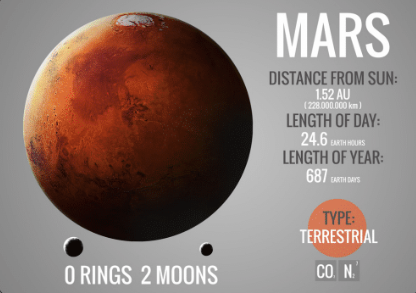The Red Planet
Mars is the fourth planet from the Sun, and it is the second smallest planet in the solar system. It is a terrestrial planet with a thin atmosphere of mainly carbon dioxide. Mars is also often mentioned as the ‘Red Planet’ because of its reddish appearance. This red colour is due to the rock and dust covering its surface being rich in iron. The ancient Greeks called the planet ‘Ares’ after their god of war. Other ancient cultures also focused on its colour. To China’s astronomers, it was the ‘Fire Star’, and Egyptian priests called it ‘Her Desher’, or ‘the red one’. Then the Romans associated the planet’s blood-red colour with Mars, their own god of war, and the name stuck. Olympus Mons on Mars is the largest and highest mountain in the solar system at more than 25 kilometres high. That’s three times higher than Mount Everest. It is so big that astronomers could see it through telescopes in the 19th century, almost 200 years ago! Mars has the largest dust storms in the Solar System. They can last for months and cover the entire planet. The seasons are extreme, and the Sun appears about half the size as it does on Earth. Mars doesn’t have a protective layer of atmosphere like the Earth, so it can’t store the heat from the Sun. As a result, the temperature on Mars regularly drops to -82 degrees Celsius in winter and only rises to -5 degrees Celsius in the summer. For years, scientists have known that Mars has got water in the form of ice. The first signs of trickling water were dark stripes or stains on crater walls and cliffs in satellite images. But this does not mean that there is life on Mars.

